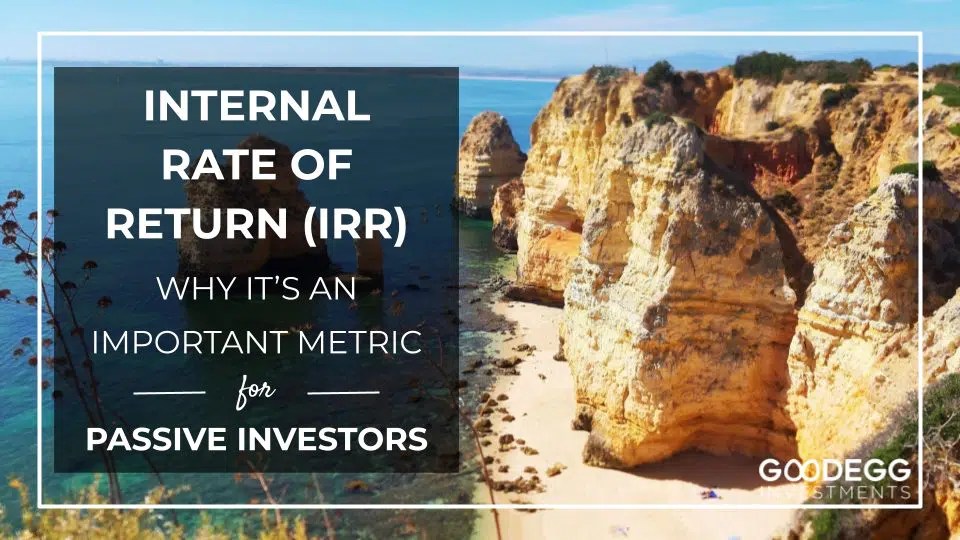If you’ve been wanting to get started as a passive investor by investing in your first real estate syndication, you’re in the right place. We’ve been focusing on producing explanatory, demystifying articles to help break down and simplify some of the most complicated topics like cap rate, the fees charged, the capital stack, and now, the IRR.
I, too, love to feel fully informed and confident in my education about and understanding of a specific topic before investing a ton of money into it, so I don’t blame you a bit! In just a few minutes, you’re going to learn what IRR is, how it’s different from ROI, where to discover the IRR when looking at a deal, and why you should even care about the IRR.
Myths Associated With Passive Real Estate Investments
First, let’s debunk a couple of myths about real estate syndications. Most would-be-successful syndication investors get stuck on the sidelines simply because they believe these myths:
Myth #1: Lower Control
It’s often rumored that when you invest in a real estate syndication, you’ll have low control over the investment asset, thus reap lower returns. However, as with any set-it-and-forget-it type investment, you exert your control upfront while you’re reviewing the executive summary and choosing a deal that aligns with your values. Then, you get to put on your passive investor hat, sit back, and enjoy the passive income.
Myth #2: Lower Return
Another myth associated with passive investments is that since you have lower control than you would on a standard rental property, you’ll have lower returns. Active investors are typically all-in on their rental property, and that means they’re liable for losses too. With passive investing, you’re able to enjoy all the upside of being invested in real estate like tax benefits, distributions, community improvement, and appreciation while also limiting your liability and maintaining your time freedom.
One way you can ensure you’re getting a great return on your investment capital is by comparing IRR across your investment opportunities.
What Is IRR and Why Should I Care?
So, now you’re wondering – What is IRR, and how do I calculate it?
IRR is the internal rate of return, the real estate syndication standard metric used to compare the return on your investment with the length of time included in the calculation. Typical ROI (return on investment) calculations don’t consider how long it will take to collect your returns. Consider this:
If you could invest $100K and make $300K, is that a good investment?
Before you jump up with a “heck yeah!” there are a few things to consider, mainly the time it would take to collect that $300K. If it took ten years to achieve those returns, that’s probably not a good deal, but if it were five years, then maybe I’d second your exclamation.
The other question is, what return is being reflected by that $300K? Is that overall ROI, or should you be looking at annualized ROI? The shorter the hold period, the higher the Annualized ROI will be while the overall ROI wouldn’t change. So, now you can see why it’s important to know what type of return you’re reading about.
The struggle gets real when you’re attempting to compare multiple deals with varying timeframes. For example, if you’re trying to choose between a five-year value-add opportunity and a seven-year syndication deal, the ROI won’t help you. This is where you need the IRR – so you can include the length of time your capital is invested and accurately compare the returns you might earn.
Avoiding Mental Gymnastics Whenever Possible
It would be tough and confusing to compare different deals of varying lengths, classes, and types without a clear IRR on each deal. And just in case you’re just dying to revive your inner mathematician, here’s the formula:

Don’t worry, though; you don’t have to calculate it yourself unless you want to. Here at Goodegg, we like simplicity, remember?
That’s why we provide IRR along with a chart of other variables and how they could affect the IRR in the financial section of each deal’s investment summary. The IRR is negative until your returns equal the amount of capital you’ve invested, and then it’s 0%. After that, when your returns surpass the amount of your initial investment, then the percentage starts to grow positively.
The more monthly distributions investors receive in a shorter timeframe, the faster IRR reaches a positive percentage. In addition, early sales of the asset and profit distributions from that sale also make the IRR skyrocket – because investors can earn their returns in a shorter period. Wouldn’t you love to double your money in three years instead of five? I would!
Variables That Impact The IRR On A Real Estate Syndication
You may see an easy-to-find IRR printed in the executive summary, but keep in mind that it may be based on the entrance cap rate. The IRR moves as the cap rate moves. This is why we suggest you investigate further and find the sensitivity analysis in the financial section of the investment summary. In this section, you should be able to see a chart similar to that below, where a varying cap rate, among other factors, reflects an adjusting IRR.
Other factors that profoundly affect the IRR (internal rate of return) on a real estate syndication investment are the asset class and the strategy.
A stabilized A-class apartment syndication may have a 7-year term with no refinance opportunity and an IRR between 13%-15%. In contrast, a B-class value-add multifamily syndication may reflect a 5-year business plan, refi opportunity, and forced appreciation from the renovations that push IRR up into the 14%-17% range. So although these are both apartment complexes, maybe even in the same metropolitan area, you’re comparing two different appreciation strategies and two different classes.
One underwriting variable that affects IRR is whether and how the general partners can get units to market rent. If per unit and overall property upgrades with generally low cost will increase demand and raise the rates and occupancy, that will boost the NOI (net operating income), positively impacting IRR.
Underwriting can boost NOI and IRR by adding additional streams of income to the property and through harvesting operational efficiencies. Things like laundry services, mail delivery lockboxes, new property management, and payment software for tenants could drastically improve the experience for tenants and support higher rent rates.
Exercise Your Own Due Diligence Beyond IRR
Beyond the IRR, you should also examine each prospective deal for its alignment with your strategy. Consider the types of syndications you’re interested in – multifamily, mobile home parks, developmental, self-storage, etc.
Each varying asset type, class, and market boasts different metrics. Weigh whether the market exhibits high growth trends in favor of increased occupancy and rent rates and decide if you’re comfortable having your investment capital locked in for three, five, or seven years.
Another significant factor is, of course, the operator. Do you agree with their philosophy and the way they run their business? Do you know, love, and trust them? Here at Goodegg, at the forefront of our philosophy is capital preservation, monthly distributions, and then appreciation. Therefore, we specifically seek out investment opportunities with these goals in mind.
Other deal metrics to investigate and compare include the breakeven occupancy rate, expense ratio, the deal structure, and loan or debt details. In general, the lower the breakeven occupancy rate and the expense ratio, the better. Deal structures can include various combinations of splits and preferred returns and loans on the property can reflect a wide range of options.
As always, your selection should be in line with your values and investment goals, plus within your risk tolerance.





